外研版九年级英语上册 Module 6 unit3 Language in use.学案
- 格式:doc
- 大小:31.50 KB
- 文档页数:4
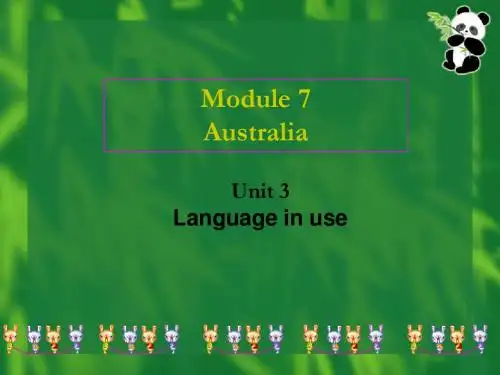
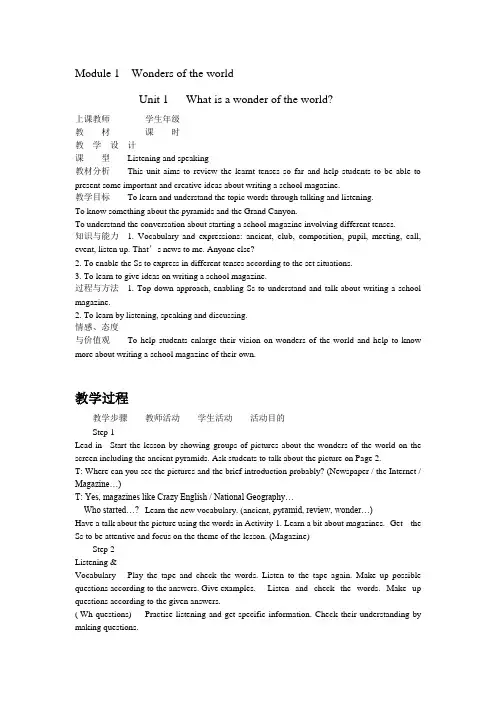
Module 1 Wonders of the worldUnit 1 What is a wonder of the world?上课教师学生年级教材课时教学设计课型Listening and speaking教材分析This unit aims to review the learnt tenses so far and help students to be able to present some important and creative ideas about writing a school magazine.教学目标To learn and understand the topic words through talking and listening.To know something about the pyramids and the Grand Canyon.To understand the conversation about starting a school magazine involving different tenses.知识与能力 1. Vocabulary and expressions: ancient, club, composition, pupil, meeting, call, event, listen up. That’s news to me. Anyone else?2. To enable the Ss to express in different tenses according to the set situations.3. To learn to give ideas on writing a school magazine.过程与方法 1. Top-down approach, enabling Ss to understand and talk about writing a school magazine.2. To learn by listening, speaking and discussing.情感、态度与价值观To help students enlarge their vision on wonders of the world and help to know more about writing a school magazine of their own.教学过程教学步骤教师活动学生活动活动目的Step 1Lead-in Start the lesson by showing groups of pictures about the wonders of the world on the screen including the ancient pyramids. Ask students to talk about the picture on Page 2.T: Where can you see the pictures and the brief introduction probably? (Newspaper / the Internet / Magazine…)T: Yes, magazines like Crazy English / National Geography…Who started…?Learn the new vocabulary. (ancient, py ramid, review, wonder…)Have a talk about the picture using the words in Activity 1. Learn a bit about magazines. Get the Ss to be attentive and focus on the theme of the lesson. (Magazine)Step 2Listening &Vocabulary Play the tape and check the words. Listen to the tape again. Make up possible questions according to the answers. Give examples. Listen and check the words. Make up questions according to the given answers.( Wh-questions) Practise listening and get specific information. Check their understanding by making questions.Step 3.Listen &read Play the tape for the 1st time. Ask Ss questions.T: What are the children doing?Is there a school magazine inDa Ming’s school?Listen to the tape and get the answers. Listen to get a general idea for the 1st time.Play the tape again and ask students to decide T OR F.①Crazy feet is a band.②Becky Wang started a school magazine.③Da Ming watched the interview on TV yesterday④Tony is writing a composition. Listen more carefully for the 2nd time. Decide whether they are true or false. Check the answers with the class. Listen for the specific information and understand the details of the conversation.Step 4.Read Play the tape again and get Ss to practise the conversation. Check the language points. Focus on everyday English and useful expressions.(Listen up, Anyone else? do some review, do an interview, on=about, get better grades)Get Ss to make a list of the articles in magazines.Check the answers in Activity 4. Read theconversation aloud, and read in role. Answer the questions in Activity 4. Practise reading and go over how to give suggestions when in discussion. Learn more about writing a school magazine.Step 5.Pair work Go through the five questions and highlight the key words. Ask for more answers on Question 3. Ss take turns to answer the questions. Consolidate the key words and transit to the next step by Question 3.Step 6.Discussion Tell the Ss:If your school decides to start a magazine, what are you going to write about? And why? They can make up lists and take Activity 3 as an example.Report their discussion. Work out the lists and talk about their plans to write the magazine. Beginning: Our school will start a magazine. What articles are you going to write... Learn to discuss in the way as the children do. Check Ss’ creativity.作业布置Collect information about the seven wonders of the world. (Pictures and brief introductions)板书设计Unit 1 What is a wonder of the world?school magazine That’s news to me!a wonder What’s it about?ancient pyramids listen upwrite a composition Any more ideas?/ Anyone else?do some reviews about… on=aboutdo an interview withUnit 2 Iwas on the edge of the Grand Canyon.上课教师学生年级教材课时教学设计课型Reading and writing教材分析By example this unit presents a good way to describe what one sees and feels after a journey. It can help students to know more about the Grand Canyon, and inspire Ss to love and explore the natural wonders.教学目标To get information from the reading material about the Grand Canyon;To learn the way of writing about what you see and your feelings when traveling;知识与能力 1. Vocabulary and expressions: waterfall, stranger, rock, ground, canyon, reply, rise, face, get out of, look over, disappear into, look (across) to…light-dark, clear, huge, beside, below, at the bottom of, reach the top. …too…to…2. To enable the Ss to express in different tenses according to the set situations.3. To love the wonders of the natural world and give facts and opinions.过程方法 1. Interactive approach.2. To improve Ss reading skills and get them to talk and practise writing by imitating.情感、态度与价值观To help students enlarge their vision on wonders of the world and help to write a description of a wonder that they have seen or visited.教学过程教学步骤教师活动学生活动活动目的Step 1Lead-in Ask Ss to show information about the seven natural wonders. (The teacher can get the related pictures ready beforehand)Present words in Activity 1. Talk and give facts about the wonders. Encourage Ss to describe withthe words given. Check up Ss’ homework and start the new topic.(Wonders)Step 2.Ask andanswer Ask Ss to make questions about facts of the natural wonders.Demonstrate and get Ss to follow. Ask andanswer.How tall/deep…is it?It’s…meters tall/deep.Practise asking about detailed information and learn the sentence pattern.Step 3.Read(Skimming)Tell Ss to read the passage in Activity 2. Find out the name of the wonder and its facts.T: Where did the writer visit?How deep/wide/long is it? Read thepassage andanswer thequestions. Find out the facts and write them down in Activity 5. Practise reading skills and get specific information.Step 4Readand match Play the tape and get Ss to follow silently. Find out the main idea of each paragraph. Present the five topic sentences on the screen (Bb).A. The writer arrived there on the rainymorning;B. The first impression/sight of theGrand Canyon.C. The Grand Canyon is the greatestwonder in his opinion.D. Details about the Grand Canyon.E. After minutes’ walk, he came to it.Ss follow the lines and match thetopic sentences tothe paragraphs.(or they canconclude the main idea by themselves if possible) R ead for the main idea of each paragraph. Learn to sum up and help to understand the whole passage.Step 5Read aloudGet Ss to read aloud after the tape and find the details about the trip.①When did he get to the GrandCanyon?②Why was there nothing to see?③Where was he facing on the edge ofthe Grand Canyon?④How did he feel about the Canyon? Read aloud and answer questions in Activity 3. Ask for help if they have any problems. Practise reading and learn about the details, check their understanding.Step 6.Focus Now get Ss’ attention to those phrasal verbs and prepositional phrases. Try to check by a gap-filling exercise.(get out of, go through, look over, fall away, on the edge of, look down/across to, at the bottom of,disappear into, ask oneself ) Learn the verbs and phrases. Practising usingthem with thehelp of thegap-filling. Focus on the phrasal verbs and prepositions.Step 7.Match Activity 4Ask Ss to find these words in the passage and guess their meaning within the sentence.Underline thewords and match the Englishmeaning. Practise guessing the meaning of words in the context.Step 8.Writing Tell Ss to imagine they have seen (some of them did see) one of the wonders of the world. Write sentences describing how they felt. Remind them of the four keywords: saw, size, happened, felt.First get them to work in pairs and then report the sentences or passage if possible. Write sentences according to the given beginning. Report theiranswers and tryto make theminto a passage. Practise writing and using the language on the basis of imaging and personal experience.作业布置Finish writing the description of one of the wonders of the world, trying to collect some details and take the text as a model.板书设计Unit 2 I was on the edge of the Grand CanyonThe seven natural wonders of the worldHow tall/wide/deep is it? It’s…tall/wide/tall.get out of on the edge of ask oneselfgo through look down/across to huge=very very biglook over at the bottom of the greatest wonderfall away disappear intoUnit 3 Language in use上课教师学生年级教材课时教学设计课型Revision and application教材分析This unit serves to give a review and summary towards the language points learnt in U1&.2.And it helps to clarify the exact differences among tenses.教学目标To review and check the words learned in this module;To summarise and consolidate tenses learnt before;知识与能力 1. Vocabulary and expressions: height, lift, view, attract, description, location, design2. To enable the Ss to differ the tenses learned in situations.3. To make a poster of a wonder of the world/ one’s hometown.过程方法 1. Formal and interactive practice, task-based.2. Comprehensive ways of practising and consolidating.情感、态度与价值观To help students enlarge their vision on wonders of the world;To make a poster of a wonder of the world or his hometown and help to love one’s motherland.教学步骤教师活动学生活动活动目的教学过程Step 1Revision Ask Ss to watch and listen to the MV Chinese by Andy Lau. Get them to find out the wonder in it.Encourage Ss to describe what they see in it , e.g.The Great Wall is a great wonder.Andy Lau went to the Great Wall.He was singing on it.He has sung many popular songs.…Watch and talk about things appear in the MV. Learn to tell the differences amongthe tenses. Help to establish the concepts of tenses in situations.Step 2.Grammar focus 1. Read through the sentences in the box with the whole class. Call back ideas about the structure highlighted from the students.2. Give hand-out to Ss and ask them to match the exact meaning with the corresponding sentence. (Activity 1)Check the answers right after that. 1. Read aloud the seven sentences. And tell the making-up of each tense.2. Read through the 5 pairs of sentences in different tenses and match. Practise telling the differences and meanings.Step 3.Writing1. Go back to the picture of the Great Wall. Give examples by matching the three parts.The Great Wall + is + about 6,700 km long.Give Ss tips on how to decide.2. Encourage Ss to observe and decide the forms of verbs in different tenses. 1. Observe thesubjects and theadverbial or even the phrasal verbs. Match the three parts to make possiblesentences.2. Read through the uncompleted passage and try to give the correct forms of verbs in the situations. Learn to observe and practise language in different tenses.Step 4Speaking 1. Show up the photo of visiting the Great Wall. Get Ss to ask the teacher questions in Activity 4. (Example)Get Ss to work in pairs, and ask and answer the questions.2. Present wonders in the local area.Get Ss to talk about them. 1. Ss follow theteacher and make up their ownconversations.Perform in front of the class.2. Learn the example in Activity 5 and make a similar introduction to the wonders in local area.Practise speaking and enable Ss to use the language and understand its meaning.Step 5VocabularyGame Present nine pictures about wonders of the world, each of which links an exercise in Activity 6/8. Get Ss to finish them first and check in forms of game. Elaborate on the Pyramids in Egypt. (More related photos) Finish the multiple- choices exercises and choose the pictures they’re interested in to check the answers. With the help of games, Ss can review the phrasal verbs and concepts of tenses.Step 6.Listening Present the three photos in Activity 7Ask about facts about any one of them. Play the tape for Ss to learn more. Listen and match the notes with the photos.Check the answers after listening and report about the three wonders with the help of the table.Learn more about the three wonders, practising describing.Step 7.Around the world Get Ss to look at the picture and read silently through the introduction. Give questions to check theirunderstanding. Read and decide, trying to grasp the main information. Learn about another wonder of the world.Step 8.Module task Tell Ss to work in groups of 4. Read through the instructions. Help them to decide what to write about.Hold up a show-and-tell session where Ss can display and discuss. Work in groups of 4 and write about one wonder they like. Collect sufficient information and make the poster. Take part in the show-and-tell session.Take this task as an extensive learning activity to get Ss to learn more about the wonders.作业布置Finish off the poster after class and get ready for the show at the back wall of the classroom. Prepare the show-and-tell session in groups of four.板书设计Unit 3 Language in useStructures of different tenses ancientThe Great Wall is a wonder… modern wondersAndy Lau went to the Great Wall. naturalHe was singing on it height—What’s the height of…?We are listening to him now. on the journey of…He has sung many pop songs. because / because ofHe will visit it some other day.Module 2 Great books一、教学内容分析本模块的话题是谈论书、作家、思想家、戏剧、电影、诗歌等。
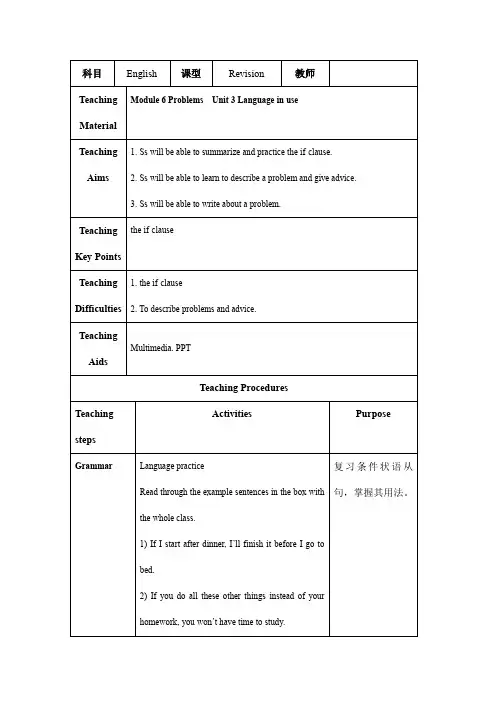
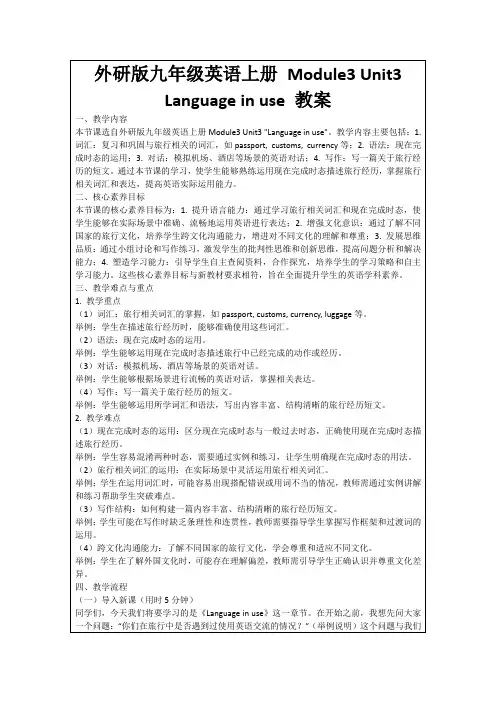

九上Module 3 Unit 3 重点句型总结重点句型Who have you chosen to tell us about?你打算跟我们谈论谁?·基本用法choose to do sth 意为:选择做某事,如:On the other hand, many women choose to go out to work.另一方面,许多妇女又选择外出工作。
Why do so many people choose to leave their country?为什么有这么多人要离开祖国?She's my hero because she’s one of the best players in the world.她是我心目中的英雄,因为她是世界上最好的运动员之一.·基本用法这是because引导的原因状语从句,表示直接的原因,但because不能与so连用。
I was ill, so I had to stay at home。
Because I was ill, I had to stay at home。
我生病了,所以我不得不待在家里。
·知识拓展--词义辨析:as/because/for/since这四个词都可以用作连词,表“原因、理由”但有区别:1. as:因为;既然,表示的原因或理由是明显的.语意不如because强。
当理由是明显的,或者被认为是已知的时,则以用as 为好。
如:As he was not well, I decided to go without him。
因为他身体不好,我决定独自去了。
As it was getting very late, we soon turned back.因为已很晚了,我们很快就回来了.2. because:因为,表直接而明确的原因或理由,即必然的困果关系。
在这几个词中,它的语意最强。
回答以why 引导的特殊疑问句时,只能用because。
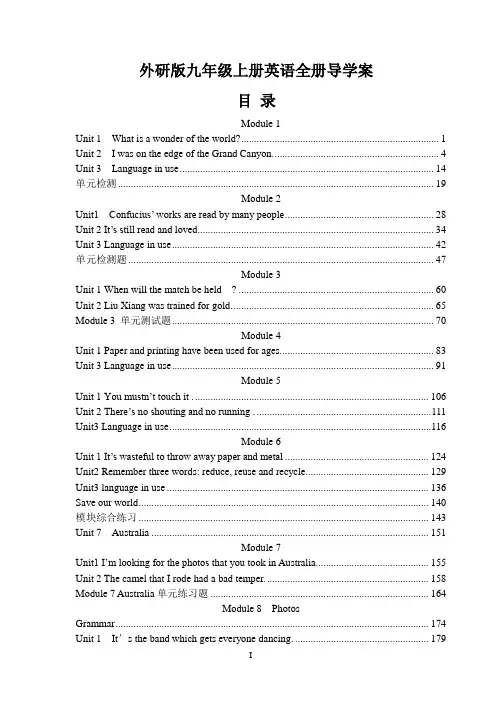
外研版九年级上册英语全册导学案目录Module 1Unit 1 What isa wonder of the world? (1)Unit 2 I was on the edge of the Grand Canyon. (4)Unit 3 Language in use (14)单元检测 (18)Module 2Unit1 Confucius‘ works are read by many people (28)Unit 2 It‘s still read and lov ed (34)Unit 3 Language in use (42)单元检测题 (47)Module 3Unit 1 When will the match be held ? (60)Unit 2 Liu Xiang was trained for gold. (64)Module 3 单元测试题 (70)Module 4Unit 1 Paper and printing have been used for ages. (83)Unit 3 Language in use (91)Module 5Unit 1 You mustn‘t touch it (106)Unit 2 There‘s no shouting and no running . (111)Unit3 Language in use (116)Module 6Unit 1 It‘s wasteful to throw away paper and metal (124)Unit2 Remember three words: reduce, reuse and recycle (129)Unit3 language in use (136)Save our world (140)模块综合练习 (143)Unit 7 Australia (151)Module 7Unit1 I‘m looking for the photos that you took in Austr alia. (155)Unit 2 The camel that I rode had a bad temper. (158)Module 7 Australia单元练习题 (164)Module 8 PhotosGrammar (174)Unit1 It's the band which gets everyone dancing. (179)Unit 2 Read on to find out who the winners are. (184)Unit 3 Language in use (188)单元学情检测 (195)Module 9Module 9 Cartoon stories (209)Unit 2 There are several fan clubs in China which have held birthday parties for Tintin.213 Module 9 Cartoon stories (218)Module 10Unit 1 I‘ve got a friend (231)Unit 2 Jamie is a cook whose ideas are changing school dinners (236)Module 10 Fitness (240)Module 10 单元测评 (246)Module 11Unit 2 It was a quiet country village. (260)Unit 3 Language in use (265)单元检测题 (269)Module 12Unit 1 Your host family is meeting you at the airport. (279)Unit 2 Learn English in Los Angeles. (285)Unit 3 Language in use (291)单元测试题 (297)导学案参考答案Module 1 (304)Module2 Great books (306)Module 3 Sporting life (308)Module 4 Great inventions (310)Module 5 Museums (312)Module 6 Save our world (314)Module 7 Australia (316)Module 8 Photos (319)Module 9 Cartoon stories (323)Module 10 Fitness (324)Module 11 Population (327)Module12 Summer in LA. (330)Module 1 Wonders of the world Unit 1 What is a wonder of the world?课型:听说课一.教学目标:1. 熟练掌握本单元的语言点。
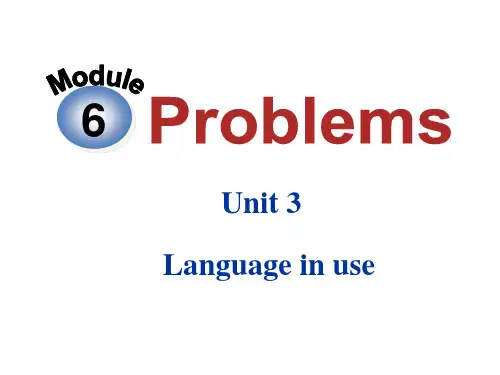
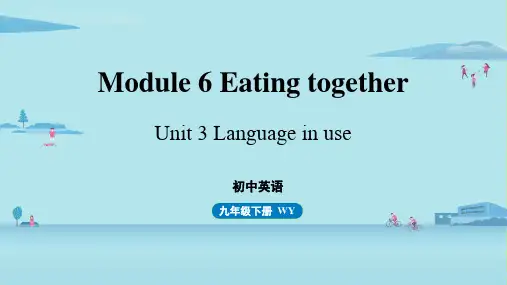
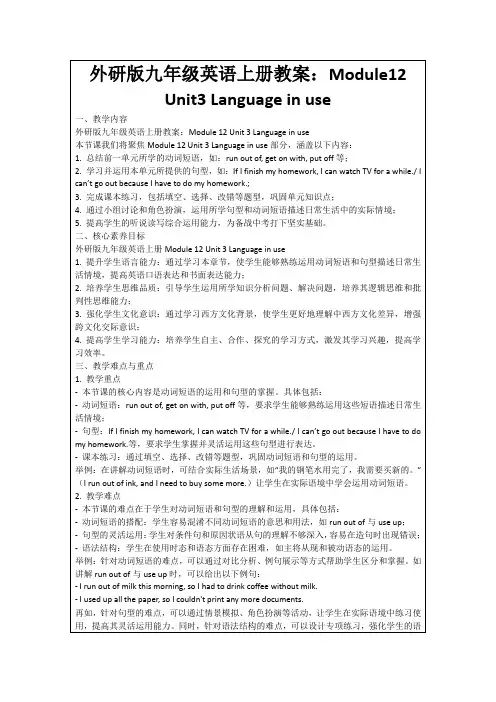

Module 3 Unit 3 重点词汇总结重点词汇including·原文再现She’s won many world competitions, including four gold medals in the Olympics.她赢了许多世界比赛,其中包括四块奥运会金牌。
·基本用法including prep. 包含;包括,和其后的名词/代词一起形成介宾短语。
There are 40 students in the classroom, including me.包括我在内,教室里有40名学生。
·知识拓展--相关单词1. include vt. 包括,包含;算在内,列在里面。
如:Is service included in the bill?帐单中包含服务费吗?2. included adj. 包括在内,无比较级和最高级形式。
如:Everyone laughed, me included.每个人都笑了,包括我在内。
medal·原文再现She’s won many world competitions, including four gold medals in the Olympics.她赢了许多世界比赛,其中包括四块奥运会金牌。
·基本用法medal n. 奖牌;奖章 gold medal 意为:金牌。
He got a medal for bravery.他因勇敢而获得一枚奖章。
They'll make a medal in memory of the great victory.他们将为纪念这一伟大的胜利制作一枚纪念章。
·知识拓展--词义辨析:prize/medal1. prize “奖赏,奖金,奖品”,多指在竞赛、竞争或抽彩中所赢得的奖。
这种奖赏有的凭能力获得,有的凭运气获得。
Hundreds of prizes can be won in our newspaper competition.参加我们报纸的竞赛可赢得数以百计的奖品。

九年级英语上册教案(全一册共91页)目录Module 1Wonders of the worldUnit 1It's more than 2,000 years old.Unit 2The Grand Canyon was not just big.Unit 3Language in useModule 2Public holidaysUnit 1My family always go somewhere interesting as soon as the holiday begins.Unit 2We have celebrated the festival since the first pioneers arrived in America.Unit 3Language in useModule 3HeroesUnit 1She trained hard,so she became a great player later.Unit 2There were few doctors,so he had to work very hard on his own.Unit 3Language in useModule 4Home aloneUnit 1I can look after myself,although it won't be easy for me.Unit 2I became so bored with their orders that I wished they would leave me alone. Unit 3Language in useModule 5MuseumsUnit 1Don't cross that rope!Unit 2If you ever go to London,make sure you visit the Science Museum.Unit 3Language in useModule 6ProblemsUnit 1If I start after dinner,I'll finish it before I go to bed.Unit 2If you tell him the truth now,you will show that you are honest.Unit 3Language in useModule 7Great booksUnit 1We're still influenced by Confucius's ideas.Unit 2It is still read and loved.Unit 3Language in useModule 8Sports lifeUnit 1 Daming wasn't chosen for the team last time.Unit 2He was invited to competitions around the world.Unit 3Language in useModule 9Great inventionsUnit 1Will computers be used more than books in the future?Unit 2Will books be replaced by the Internet?Unit 3Language in useModule 10AustraliaUnit 1I have some photos that I took in Australia last year.Unit 2The game that they like most is Australian football.Unit 3Language in useModule 11PhotosUnit 1He's the boy who won the photo competition last year!Unit 2The photo which we liked best was taken by Zhao Min.Unit 3Language in useModule 12Save our worldUnit 1If everyone starts to do something,the world will be saved.Unit 2Repeat these three words daily:reduce,reuse and recycleUnit 3Language in useModule 1Wonders of the worldUnit 1It's more than 2,000 years old.【教学思路】本单元的教学内容是第一模块中的第一单元,通过提供必要的图片、背景等为学生创造一个全新的语言氛围。
Module 6 Unit 3 Language in use 同步卷3一.选择题(共7小题)1.﹣Alice,you ______ on the phone.﹣I'm coming.Thanks.()A.want B.wantedC.are wanting D.are wanted2.﹣I'm not sure which tie to wear for the party.﹣﹣God!I have no idea,______.()A.too B.neither C.either D.also3.Look!How heavy the rain is!You'd better ______.()A.don't go nowB.stay here when it stopsC.not leave until it stopsD.not to leave at once4._____worried about me,Mom.I've grown up.()A.Don't B.Don't be C.Not D.Not be 5.Taiwan is part of China.We _______ the same history and culture.()A.explain B.express C.connect D.share6.Here ________ the photos that I took in Hong Kong.()A.is B.are C.be D.have7.The man left the room angrily without a word.()A.say B.said C.saying D.to say二.填空题(共5小题)8.My English teacher is(help).With her help,I have made great progress in my English.9.人们的味觉得到了提高.People's of is improved.10.你姓什么?What's your.11.我不想长胖.I don't want.12.他们齐心协力,很快完成了工作.They and finished the work soon.三.词汇应用(共2小题)13.The trees(grow)by Class Two tomorrow.14.Jack(look after)by a new teacher next week.四.补全对话(共1小题)15.根据短文内容,用方框中所给词语的适当形式填空,使文章通顺、完鉴。
Unit 3 language in use基础篇一、单项选择。
1. As China grows stronger and stronger, Chinese ______ in more and more schools out of our country.A. teachesB. is taughtC. has taughtD. was taught【答案】A【解析】试题分析:句意:随着中国变得越来越强大,汉语在国外越来越多的学校教学。
A. teaches第三人称单数形式;B. is taught 一般现在时的被动结构C. has taught 现在完成时,主动结构;D. was taught 一般过去时的被动结构。
根据主语和谓语动词之间是动宾关系,所以用被动语态,根据句意,可知描述的是现在的一种现象,所以用一般现在时,故选B。
考点:考查被动语态的时态的用法。
2. Teenagers have to be 18 years old before they ______to drive a car.A. are allowedB. will be allowedC. allowD. is allowing【答案】B【解析】试题分析:句意:青少年在允许开车前不得不达到十八岁。
are allowed被动语态的一般现在时;C.will be allowed 被动语态的一般将来时;D.allow一般现在时。
根据主语和谓语动词之间的动宾关系,可知用被动语态,结合句意,可知表示一般情况,故选A。
考点:考查被动语态的用法。
3. My sister________ her cat yesterday,but she didn't________ it.A. found;look forB. looked;foundC. looked for;find【答案】C【解析】句意:昨天我的姐姐寻找她的猫,但是她没有找到它。
Module 6Unit 3Language in use 及语法目标导航重点短语 1.拒绝做某事2.积攒3.参加4.是否5.一个小角色6.因(不)做某事而警告某人重点句型 1.上课认真听,否则你将不知道要做什么。
Listen in class,or you will not understand.2.他们已经因他没有努力学习而警告他了。
They have him not working hard.3.我想参加今年学校的小提琴比赛,但是我不确定是否应该参加。
I want to the school violin petition this year,but I amnot sure I should.4.在学校话剧中,我获得了(演)主角(的机会),而琳达只得到一个小角色。
I have got in the school play,but Linda has only got asmall part.【答案】♦重点短语1.refuse to do sth.2.save up3.take part in4.whether...or not5.a small part6.warn sb.about (not) doing sth. ♦重点句型1.what to do2.warned;about3.take part in;whether;or not4.the biggest part知识精讲知识点01Eat your breakfast, or you will get hungry at school. 吃早餐,否则你在学校挨饿的。
【考点1】本句使用句型“祈使句+and/or+陈述句”,祈使句是陈述的条件,and意为“那么”,or意为“否则”。
如:Give me one more hour, and I’ll get the work finished. 再给我一个小时,我就会完成这项工作。
Hurry up, or you’ll miss the meeting. 如果你不快点,你就会错过会议。
Module 6 ProblemsUnit 3Language in use教学目标:1.语言目标:To summarise the use of adverbial clause: if…will…2.情感目标:培养良好人心态面对困难。
3.能力目标:培养发现问题,分析问题,解决问题人能力。
4.思维能力:培养逻辑思维。
Step1:learning by yourself. (Review the phrases)Change the phrases into English1.在…的末端_____________2. 生某人的气____________3.以…为荣_______________4. 听从…_________________5.放弃______________Step2:Complete the passage with the correct form of the expression in the box. A4,A5.P47 Complete the conversation with the correct form of the words and expressions in the box.A c i v i t y4 honest pocket money problem refuse repair terrible truth wear May: What’s up? You look really sad.Kate: Yes, I feel (1) _________.May: What’s wrong? Tell me about it.Maybe I can help.Kate: Well, I needed some new shoes to wear toa party. But I didn’t have enough (2)_____________ to buy any. So I asked mysister if I could wear her new shoes.May: Did she agree?Kate: No, you see, that’s the (3) ________. She(4) _______ to let me wear them, becauseshe bought them for her sixteenthbirthday party. They were expensive. Shesaved up a lot of money to buy them. ButI took them when she was out and(5)_________ them to the party. Them onmy way home, I fell, and one of the shoesis broken.May: Can you (6) ________ it?Kate: No, I don’t think anyone will be ableto do that.May: Then you must tell her the (7)_________. If you aren’t (8)__________, she’ll be even angrierwith you.Kate: I know you’re right. I’ll do as you said.P47.Step3:Activity 5 Complete the passages with the correct form of the expressions in the box.at the end of be angry withbe proud of listen toDear Diana,My grades are not very good, and my parents (1) ______________ me. I told them that I worked hard at school. The problem is, I am just not good at schoolwork.are angry withB u t t h e y t h i n k I s p e n d t o o m u c h t i m e p l a y i n g b a s k e t b a l l w h e n I s h o u l d b e s t u d y i n g.I t i s t r u e t h a t I p l a y a l o t o f b a s k e t b a l l b e c a u s e I t h i n k b a s k e t b a l l i s s o m e t h i n g g r e a t.I a m i n t h e s c h o o l t e a m a n d I (2)_____________t h a t.I w a n t t o b e i n t h e n a t i o n a l t e a m s o m e d a y.M y u n c l e h a s o f f e r e d t o h e l p m e t r a i n t o o,b u t n o w h o w c a n I g e t m y p a r e n t s t o a g r e e?M a r yam proud ofDear Mary,You should also work very hard at school. If your grades are better (3)_____________ this term, your parents will not worry so much. Then you can ask your uncle to talk to them. Maybe your parents will (4)_________ him.Step4:Observe the following examples carefully. They are all from this module.If I start after dinner, I’ll finish it before I go to bed.If you do all these other things instead of your homework, you won’t have time to study.He thinks something will go wrong if I play games on it.一.If引导的条件状语从句结构:二、If从句的时态1. If I start after dinner, I’ll finish it before I go to bed.2.If he runs, he’ll get there in time.一般现在时Step5:Summary if从句用______________,主句用___________。
简称:主将从现一般将来时●If you ____ to the party, you’ll have a●great time.● A. will go B. went C. go D. going● 2. I ______ her the answer if she _______me.● A. can tell, will ask B. will tell, will ask● C. would tell, ask D. will tell, asks1.She may come with us if she arrives in time.2.If it stops snowing, we can go out.一般现在时情态动词+动词原形1.We___study hard if we want to pass the final exam.A. willB. mustC. canD. could三、If引导的条件状语从句位置。
1.I’ll go to see you if I have time.2.If it rains tomorrow, we’ll stay athome.归纳:if 引导的条件状语从句位置可直接放在主句_____,也可以放在______。
放在句首时,从句后面要用_______和主句隔开。
Step6:Exercese:1.-What are you going to do tomorrow?-We’ll go to the library tomorrow if it ______.A. isn’t rainB. rainC. won’t rainD. doesn’t rain2. If our government ____attention to food safety now, our health ____in danger.A. won’t pay; isB. doesn’t pay; isC. won’t pay; will beD. doesn’t pay; will be四、同义句转换If you work hard, you’ll pass theexam easily.→ Work hard, and you’ll pass the exam easily.If you don’t hurry up, you’ll miss thetrain.→ Hurry up, or you’ll miss the train.快点儿,否则你就赶不上火车了。
归纳:用“祈使句+ and / or +一般将来时的句子”转换。
1.Work harder, _____you will win the game on Friday.A. ifB. becauseC. orD. and2. Do more exercise, or you won’t lose weight.(改为条件状语从句)_____you ____ ____ more exercise, you ___ lose weight.Step:7Summary●if条件状语从句结构:● 1.if从句 + 祈使句● 2.if从句 + 陈述句●二. If 条件状语从句时态:1.主将从现 2.if从句用一般现在时,主句用情态动词+动词原形。